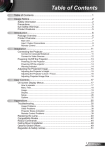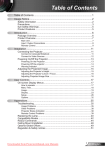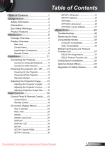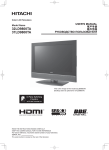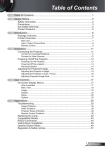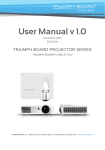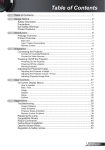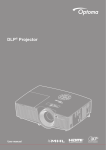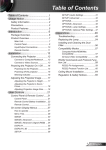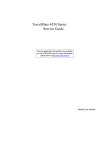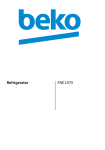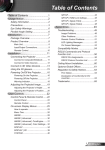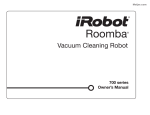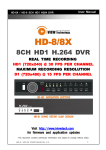Download User`s Manual
Transcript
Table of Contents
Table of Contents.............................1
Usage Notice....................................2
Safety Information................................2
Precautions..........................................3
Eye Safety Warnings...........................5
Product Features.................................5
Introduction.......................................6
Package Overview...............................6
Product Overview................................7
Main Unit............................................... 7
Control Panel........................................ 8
Input/Output Connections..................... 9
Remote Control................................... 10
Installation...................................... 11
Connecting the Projector...................11
Connect to Computer/Notebook......... 11
Connect to Video Sources.................. 12
Powering the projector On / Off.........13
Powering On the Projector.................. 13
Powering off the projector.................. 14
Warning Indicator................................ 14
Adjusting the Projected Image...........15
Adjusting the Projector’s Height ........ 15
Adjusting the Projector’s Zoom /
Focus.................................................. 16
Adjusting Projection Image Size......... 16
SETUP | Advanced............................. 40
SETUP | Network................................ 41
OPTIONS............................................ 46
OPTIONS | Advanced......................... 47
OPTIONS | Lamp Settings.................. 48
Network Application System
Introduction........................................49
How to use Web Administration . ....... 49
How to use Multi-media Card Reader
Application.......................................... 56
How to use the Optoma Presenter
System................................................ 59
Appendices.....................................64
Troubleshooting.................................64
Replacing the lamp............................69
Compatibility Modes..........................71
Computer Compatibility...................... 71
Video Compatibility............................. 73
RS232 Commands and Protocol
Function List......................................74
RS232 Pin Assignments..................... 74
RS232 Protocol Function List............. 75
Wall Mount Installation.......................79
Optoma Global Offices......................80
Regulation & Safety Notices..............82
User Controls.................................18
Control Panel & Remote Control.......18
Control Panel...................................... 18
Remote Control................................... 19
On-screen Display Menus.................24
How to operate .................................. 24
Menu Tree........................................... 25
IMAGE................................................ 27
IMAGE | Advanced............................. 29
DISPLAY............................................. 31
DISPLAY | 3D .................................... 34
SETUP................................................ 35
SETUP | Signal (RGB)........................ 37
SETUP | Security................................ 38
1
English
Usage Notice
Safety Information
The lightning flash with arrow head within an equilateral triangle is
intended to alert the user to the presence of uninsulated “dangerous
voltage” within the product’s enclosure that may be of sufficient
magnitude to constitute a risk of electric shock to persons.
The exclamation point within an equilateral triangle is intended to alert
the user to the presence of important operating and maintenance
(servicing) instructions in the literature accompanying the appliance.
WARNING: TO REDUCE THE RISK OF FIRE OR ELECTRIC SHOCK, DO NOT
EXPOSE THIS APPLIANCE TO RAIN OR MOISTURE. DANGEROUS HIGH
VOLTAGES ARE PRESENT INSIDE THE ENCLOSURE. DO NOT OPEN THE
CABINET. REFER SERVICING TO QUALIFIED PERSONNEL ONLY.
Class B emissions limits
This Class B digital apparatus meets all requirements of the Canadian
Interference-Causing Equipment Regulations.
Important Safety Instruction
1.Do not block any ventilation openings. To ensure reliable operation of
the projector and to protect from over heating, it is recommended to
install the projector in a location that does not block ventilation. As an
example, do not place the projector on a crowded coffee table, sofa,
bed, etc. Do not put the projector in an enclosure such as a book case
or a cabinet that restricts air flow.
2.Do not use the projector near water or moisture. To reduce the risk
of fire and/or electric shock, do not expose the projector to rain or
moisture.
3.Do not install near heat sources such as radiators, heaters, stoves or
any other apparatus such as amplifiers that emits heat.
4.Clean only with dry cloth.
5.Only use attachments/accessories specified by the manufacturer.
6. Do not use the unit if it has been physically damaged or abused.
Physical damage/abuse would be (but not limited to):
Unit has been dropped.
Power supply cord or plug has been damaged.
Liquid has been spilled on to the projector.
Projector has been exposed to rain or moisture.
Something has fallen in the projector or something is loose inside.
Do not attempt to service the unit yourself. Opening or removing covers
may expose you to dangerous voltages or other hazards. Please call
Optoma before you send the unit for repair.
7.Do not let objects or liquids enter the projector. They may touch
dangerous voltage points and short out parts that could result in fire or
electric shock.
8.See projector enclosure for safety related markings.
9.The unit should only be repaired by appropriate service personnel.
English
2
Usage Notice
Precautions
Please follow all warnings, precautions and
maintenance as recommended in this user’s
guide.
▀■ Warning- Do not look into the projector’s lens when the lamp is
on. The bright light may hurt and damage your eyes.
▀■ Warning- To reduce the risk of fire or electric shock, do not
expose this projector to rain or moisture.
▀■ Warning- Please do not open or disassemble the projector as
this may cause electric shock.
▀■ Warning- When replacing the lamp, please allow the unit to
cool down. Follow instructions as described on pages
69-70.
▀■ Warning- This projector will detect the life of the lamp itself.
Please be sure to change the lamp when it shows
warning messages.
▀■ Warning- Reset the “Lamp Reset” function from the on-screen
display “OPTIONS | Lamp Settings” menu after
replacing the lamp module (refer to page 48).
▀■ Warning- When switching the projector off, please ensure
When the lamp
reaches the end
of its life, the projector will not turn
back on until the
lamp module has
been replaced.
To replace the
lamp, follow the
procedures listed
under “Replacing
the Lamp” section
on pages 69-70.
the cooling cycle has been completed before
disconnecting power. Allow 90 seconds for the
projector to cool down.
▀■ Warning- Do not use lens cap when projector is in operation.
▀■ Warning- When the lamp is approaching the end of its lifetime,
the message “Lamp Warning: Lamp life exceeded.”
will show on the screen. Please contact your local
reseller or service center to change the lamp as soon
as possible.
▀■ Warning- Do not look into or point the laser pointer on your
remote control into your or someone’s eyes. Laser
pointer can cause permanent damage to eyesight.
3
English
Usage Notice
Do:
Turn off and unplug the power plug from the AC outlet before
cleaning the product.
Use a soft dry cloth with mild detergent to clean the display
housing.
Disconnect the power plug from AC outlet if the product is
not being used for a long period of time.
Do not:
Block the slots and openings on the unit provided for
ventilation.
Use abrasive cleaners, waxes or solvents to clean the unit.
Use under the following conditions:
- In extremely hot, cold or humid environments.
Ensure that the ambient room temperature is within
5 - 40°C.
Relative Humidity is 5 - 40°C, 80% (Max.),
English
4
non-condensing.
- In areas susceptible to excessive dust and dirt.
- Near any appliance generating a strong magnetic field.
- In direct sunlight.
Usage Notice
Eye Safety Warnings
▀■ Avoid staring/facing directly into the projector beam at all
times. Keep your back to the beam as much as possible.
▀■ When projector is used in a classroom, adequately supervise
students when they are asked to point out something on the
screen.
▀■ In order to minimize the lamp power, use room blinds to
reduce ambient light levels.
Product Features
▀■ SVGA (800x600) Native resolution /
XGA (1024x768) Native resolution /
WXGA (1280x800) Native resolution
Monitor loop
through only support in VGA1-In/
YPbPr.
▀■ HD compatible – 720p and 1080p supported
▀■ VGA monitor loop through
(works on standby mode > 0.5W)
▀■ BrilliantColorTM Technology
▀■ Security Bar and Kensington Lock
▀■ RS232 control
▀■ Rapid shutdown
▀■ Built-in speakers
▀■ Quick Resume and Eco+ mode
▀■ Network support
▀■ USB display
▀■ Network display
▀■ USB Reader
5
English
Introduction
Package Overview
Unpack and inspect the box contents to ensure
all parts listed below are in the box. If something
is missing, please contact your nearest customer
service center.
Projector
Due to different
applications in
each country,
some regions
may have
different
accessories.
2 × AAA Batteries
Documentation :
User’s Manual
Warranty Card
Quick Start Card
WEEE Card
English
6
(for EMEA only)
Power Cord
IR Remote Control
VGA Cable
Introduction
Product Overview
Main Unit
4
10
1
11
10
3
6
The interface is
subject to model’s
specifications.
7
Do not block projector in/out air vents.
8
2
5
9
1.
2.
3.
4.
5.
6.
Control Panel
Focus Ring
Speaker
Zoom Ring
Lens
IR Receiver
7. Input / Output
Connections
8. Power Socket
9. Tilt-Adjustment Feet
10.Ventilation (inlet)
11. Ventilation (outlet)
7
English
Introduction
Control Panel
1
4
10
2
3
5
/
9
6
/
8
1. Power LED
2. Lamp LED
3. Temp LED
4. Enter / Help
5. Menu
6. Re-Sync
7. Keystone Correction
8. Four Directional Select Keys
9. Source
10.Power/Standby button
English
8
7
Introduction
Input/Output Connections
1
2
3
4
5
6
7
8
C
(SERVICE)
15
The interface
is subject to
model’s specifications.
Mini WiFi USB
dongle, USB
thumb drive,
keyboard/mouse,
camera, etc are
optional accessories.
14
13
12
11
10
9
1. USB Connector (Connect to PC for Remote Mouse function)
2. HDMI Connector
3. RS-232 Connector (9-pin DIN Type)
4. VGA-Out Connector (Monitor Loop-through Output)
5.VGA1-In/YPbPr Connector
(PC Analog Signal/Component Video Input/HDTV/YPbPr)
6. Composite Video Input Connector
7. 3.5mm Microphone Input
8. Audio Output Connector (3.5mm Mini Jack)
9. Audio Input connector (3.5mm mini jack)
10.KensingtonTM Lock Port
11.VGA2-In/YPbPr Connector
(PC Analog Signal/Component Video Input/HDTV/YPbPr)
12.5pin Mini-USB for Display
13.USB for Mini WiFi Dongle & Thumb drive & Keyboard
Mouse.
14.RJ45
15.Power Socket
9
English
Introduction
Remote Control
1
The interface
is subject to
model’s specifications.
2
7
3
8
4
9
5
6
10
20
11
12
21
13
22
14
23
15
24
16
25
17
18
19
26
English
10
27
1. LED Indicator
2. Power On/Off
3. Source
4. Mouse Left Click
5. Enter
6.Four Directional Select
Keys / Mouse control
7.Switch (turn on/off
mouse function)
8. Re-Sync
9. Mouse Right Click
10.Page Up
11. Page Down
12. Volume +/13.Menu
14.Zoom
15.AV mute
16.Video
17.3D
18.VGA1
19.USB
20.Laser Pointer
21.Keystone +/22.Brightness
23.HDMI
24.VGA2
25. Eco+
26.Numbered keypad
(for password input)
27.Freeze
Installation
Connecting the Projector
Connect to Computer/Notebook
MOLEX
Audio Output
MOLEX
2
The interface
is subject to
model’s specifications.
6
3
4
2
5
7
9
molex
molex
PS50426E
(*) Optional
accessory
C
(SERVICE)
1
R
Due to the
difference in
applications
for each
country, some
regions may
have different
accessories.
8
1....................................................................................................Power Cord
2....................................................................................................*USB Cable
3...........................................................................................*DVI/HDMI Cable
4................................................................................................*RS232 Cable
5.....................................................................................................VGA Cable
6.........................................................................................*Audio Input Cable
7......................................................................................*Audio Output Cable
8........................................................................................*VGA Output Cable
9..............................................................................................*Network Cable
11
English
Installation
Connect to Video Sources
DVD Player, Set-top Box,
HDTV receiver
Audio Output
4
2
8
5
The interface
is subject to
model’s specifications.
3
1
(SERVICE)
C
6
R
PS50426E
Composite Video Output
Due to the
difference in
applications
for each
country, some
regions may
have different
accessories.
(*) Optional
accessory
English
12
7
1....................................................................................................Power Cord
2..................................................................................................*HDMI Cable
3................................................*15-Pin to 3 RCA Component/HDTV Adaptor
4.............................................................................*3 RCA Component Cable
5.................................................................................*Audio Cable Jack/RCA
6.................................................................................*Audio Cable Jack/Jack
7................................................................................*Composite Video Cable
8........................................................................................ *Microphone Cable
Installation
Powering the projector On / Off
Powering On the Projector
When Power mode
(Standby) is set
to Eco (<0.5W),
the VGA output
and Audio passthrough will be
deactivated when
the projector is in
standby.
1. Remove the lens cap.
2. Securely connect the power cord and signal cable. When
connected, the POWER/STANDBY LED will turn Amber.
3. Turn on the lamp by pressing “ ” button either on the top of
the projector or on the remote. The POWER/STANDBY LED
will now turn Green.
The startup screen will display in approximately 10 seconds.
The first time you use the projector, you will be asked to
select the preferred language and power saving mode.
4. Turn on and connect the source that you want to display
on the screen (computer, notebook, video player, etc). The
projector will detect the source automatically. If not, push
menu button and go to “OPTIONS”.
Make sure that the “Source Lock” has been set to “Off”.
If you connect multiple sources at the same time, press the
“SOURCE” button on the control panel or direct source keys
on the remote control to switch between inputs.
2
POWER/STANDBY
/
Turn on the
projector first and
then select the
signal sources.
/
1
Lens Cap
13
English
Installation
Powering off the projector
1. Press the “ ” button on the remote control or
on the control panel to turn off the projector.
The following message will be displayed on the screen.
Press the “ ” button again to confirm otherwise the
message will disappear after 15 seconds. When you press
the “ ” button for the second time, the fans will speed up
to cool down the projector and will shut down in 10 seconds. During this time, the led will flash green.
2. The cooling fans continue to operate for about 10 seconds
for cooling cycle and the POWER/STANDBY LED will
Flash Green. When the POWER/STANDBY LED lights
solid Amber, the projector has entered standby mode.
If you wish to turn the projector back on, you must wait
until the projector has completed the cooling cycle and
has entered standby mode. Once in standby mode, simply
press “ ” button to restart the projector.
3. Only disconnect the power cord when the projector is in
standby mode (solid amber led).
Warning Indicator
When the warning indicators (see below) come on,
the projector will automatically shutdown:
Contact the
nearest service
center if the
projector displays
these symptoms.
See pages
80-81 for more
information.
English
14
“LAMP” LED indicator is lit red and if “POWER/STANDBY”
indicator flashes amber.
“TEMP” LED indicator is lit red and if “POWER/STANDBY”
indicator flashes amber. This indicates the projector has
overheated. Under normal conditions, the projector can be
switched back on.
“TEMP” LED indicator flashes red and if “POWER/STANDBY” indicator flashes amber.
Unplug the power cord from the projector, wait for 30 seconds
and try again. If the warning indicator light up again, please
contact your nearest service center for assistance.
Installation
Adjusting the Projected Image
Adjusting the Projector’s Height
The projector is equipped with elevator feet for adjusting
the image height.
1.Locate the adjustable foot you wish to modify on the
underside of the projector.
2. Rotate the adjustable ring clockwise to raise the projector
or counter clockwise to lower it. Repeat with the remaining
feet as needed.
Tilt-Adjustment Feet
Tilt-Adjustment Ring
15
English
Installation
Adjusting the Projector’s Zoom / Focus
You may turn the zoom ring to zoom in or out. To focus the image, rotate the focus ring until the image is clear.
SVGA/XGA/WXGA series: The projector will focus at distances from 3.94 to 32.8 feet (1.2 to 10.0 meters).
Zoom Ring
Focus Ring
Adjusting Projection Image Size
SVGA/XGA series: Projection Image Size from 30” to 307.0”
(0.7 to 7.8 meters).
WXGA series: Projection Image Size from 36.3” to 362” (0.9
to 9.2 meters).
Top View
Screen
Screen (W)
Height
Projection Distance (D)
Screen
Side View
Offset (Hd)
Projection Distance (D)
English
16
Screen (H)
Dia
go
na
Width
l
Installation
SVGA/XGA
Diagonal length
(inch) size of
4:3 Screen
Screen Size W x H
(m)
Projection Distance (D)
(inch)
(m)
Offset (Hd)
(feet)
Width
Height
Width
Height
wide
tele
wide
tele
(m)
(inch)
30.00
0.61
0.46
24.00
18.00
0.98
1.17
3.20
3.84
0.07
2.70
40.00
0.81
0.61
32.00
24.00
1.30
1.56
4.27
5.12
0.09
3.60
60.00
1.22
0.91
48.00
36.00
1.95
2.34
6.40
7.68
0.14
5.40
70.00
1.42
1.07
56.00
42.00
2.28
2.73
7.47
8.96
0.16
6.30
80.00
1.63
1.22
64.00
48.00
2.60
3.12
8.53
10.24
0.18
7.20
90.00
1.83
1.37
72.00
54.00
2.93
3.51
9.60
11.52
0.21
8.10
100.00
2.03
1.52
80.00
60.00
3.25
3.90
10.67
12.80
0.23
9.00
120.00
2.44
1.83
96.00
72.00
3.90
4.68
12.80
15.36
0.27
10.80
150.00
3.05
2.29
120.00
90.00
4.88
5.85
16.00
19.20
0.34
13.50
180.00
3.66
2.74
144.00
108.00
5.85
7.02
19.20
23.04
0.41
16.20
250.00
5.08
3.81
200.00
150.00
8.13
9.75
26.67
32.00
0.57
22.50
307.00
6.24
4.68
245.60
184.20
9.98
11.98
32.75
39.30
0.70
27.63
This table is for user’s reference only.
WXGA
Diagonal length
(inch) size of
16:10 Screen
Screen Size W x H
(m)
Projection Distance (D)
(inch)
(m)
Offset (Hd)
(feet)
Width
Height
Width
Height
wide
tele
wide
tele
(m)
(inch)
36.30
0.78
0.49
30.78
19.24
1.00
1.20
3.28
3.94
0.06
2.39
40.00
0.86
0.54
33.92
21.20
1.10
1.32
3.62
4.34
0.07
2.63
60.00
1.29
0.81
50.88
31.80
1.65
1.99
5.43
6.51
0.10
3.94
70.00
1.51
0.94
59.36
37.10
1.93
2.32
6.33
7.6
0.12
4.60
80.00
1.72
1.08
67.84
42.40
2.21
2.65
7.24
8.68
0.13
5.26
90.00
1.94
1.21
76.32
47.70
2.48
2.98
8.14
9.77
0.15
5.91
100.00
2.15
1.35
84.80
53.00
2.76
3.31
9.05
10.85
0.17
6.57
120.00
2.58
1.62
101.76
63.60
3.31
3.97
10.85
13.03
0.20
7.89
150.00
3.23
2.02
127.20
79.50
4.14
4.96
13.57
16.28
0.25
9.86
180.00
3.88
2.42
152.64
95.40
4.96
5.96
16.28
19.54
0.30
11.83
250.00
5.38
3.37
212.00
132.50
6.89
8.27
22.61
27.14
0.42
16.43
300.00
6.46
4.04
254.40
159.00
8.27
9.93
27.14
32.56
0.50
19.72
362.00
7.80
4.87
306.98
191.86
9.98
11.98
32.74
39.29
0.60
23.79
This table is for user’s reference only.
17
English
User Controls
Control Panel & Remote Control
Control Panel
/
/
Using the Control Panel
POWER
Refer to the “Power On/Off the Projector” section on
pages 13-14.
RE-SYNC
Automatically synchronize the projector to the input
source.
Enter / Help
English
/
Confirm your item selection.
H
elp Menu (only available when OSD menu is not
shown).
SOURCE
Press “SOURCE” to select an input signal.
Menu
Press “Menu” to launch the on-screen display
(OSD) menu. To exit OSD, Press “Menu” again.
Four Directional
Select Keys
Use
to select items or make adjustments to your selection.
Keystone
Use
to adjust image distortion caused
by tilting the projector. (±40 degrees)
Lamp LED
Indicate the projector’s lamp status.
Temp LED
Indicate the projector’s temperature status.
POWER/
STANDBY
LED
Indicate the projector’s status.
18
User Controls
Remote Control
Using the Remote Control
Power
Refer to the “Power On/Off the Projector”
section on pages 13-14.
L Button
Mouse left click.
R Button
Mouse right click.
Page +
Use this button to page up.
Page -
Use this button to page down.
Enter
Confirm your item selection.
Source
Press “Source” to select an input signal.
Re-SYNC
Automatically synchronizes the projector to
the input source.
Four Directional
Select Keys
Use
to select items or make
adjustments to your selection.
PC/Mouse Control
Use
for emulation of USB
mouse via USB when you press “Switch”
button.
Keystone +/-
Adjust image distortion caused by tilting the
projector.
Volume +/-
Adjust to increase / decrease the volume.
Brightness
Adjust the brightness of the image.
3D
Press the “3D” to turn the 3D OSD menu
on/off.
Menu
Press “Menu” to launch the on-screen
display (OSD) menu. To exit OSD, press
“Menu” again.
HDMI
Press “HDMI” to choose HDMI source.
19
English
User Controls
Using the Remote Control
Freeze
Press “Freeze” to pause the screen image.
Press this button again to unlock.
AV mute
Momentarily turns off/on the audio and
video.
VGA1
Press “VGA1” to choose VGA1-In/YPbPr
sources.
VGA2
Press “VGA2” to choose VGA2-In/YPbPr
sources.
Video
Press “Video” to choose Composite video
source.
USB
Display the USB device.
Switch
USB mouse switch. Turns mouse function
on/off. Press twice to turn on the mouse
function. For the mouse function to work,
USB cable must be connected between the
projector and computer.
Zoom
AV mute: Save
up to 70% of the
lamp power when
AV mute is applied.
English
20
Eco+
Zoom in on an image.
Press
buttons to alter zoom.
When Eco+ mode is activated, the brightness level of the content is automatically
detected to significantly reduced lamp
power consumption (up to 30%) during
periods of inactivity.
User Controls
Using the HELP button
The HELP function ensures easy setup and operation.
Press the “ / ” button on the control panel to open the
Help Menu.
/
/
21
English
User Controls
Help menu button functions only when no input source
is detected.
Please refer to the
“Troubleshooting”
section on pages
64-68 for more
details.
If input source is detected and help button is pressed, the
following pages will appear to help diagnose any problems.
English
22
User Controls
23
English
User Controls
On-screen Display Menus
The Projector has multilingual On-screen Display menus that
allow you to make image adjustments and change a variety of
settings.
How to operate
1. To open the OSD menu, press “Menu” on the Remote Control or
Projector Keypad.
2 When OSD is displayed, use
keys to select any item in the
main menu. While making a selection on a particular page, press
or “Enter” key to enter sub menu.
3. Use
using
keys to select the desired item and adjust the settings
key.
4. Select the next item to be adjusted in the sub menu and adjust as
described above.
5. Press “Enter” to confirm, and the screen will return to the main
menu.
6. To exit, press “MENU” again. The OSD menu will close and the
projector will automatically save the new settings.
Main Menu
Sub Menu
Settings
English
24
User Controls
Menu Tree
Main Menu
Sub Menu
Image
Display Mode
Settings
Presentation / Bright / Movie / sRGB /
Blackboard / Classroom / User / 3D
-50~50
Brightness
Contrast
-50~50
Sharpness
1~15
#1
Color
-50~50
#1
Tint
Advanced
-50~50
Gamma
Film / Video / Graphics / Standard
BrilliantColor™
0~10
Color Temp.
Warm / Medium / Cold
Color Settings
Red Gain / Green Gain / Blue Gain / Red
Bias / Green Bias / Blue Bias / Cyan /
Magenta / Yellow / Reset / Exit
AUTO / RGB / YUV
Color Space
#6
Input Source
VGA1 / VGA2 / Video / HDMI / Flash
Drive / Network Display / USB Display /
Exit
Exit
Display
Format
Edge Mask
#3
4:3 / 16:9 or 16:10 / LBX / Native / AUTO
#2
4:3 / 16:9-1 / 16:9-II / Native / AUTO
0~10
Zoom
-5~25 (80%~200%)
H Image Shift
-50~50
V Image Shift
-50~50
V Keystone
-40~40
Auto Keystone
3D
Setup
AUTO / RGB (0-255) / RGB (16-235) / YUV
On / Off
3D Mode
#4
3D Sync. Invert
Exit
Language
Off / DLP-Link / IR
On / Off
English / Deutsch / Français / Italiano /
Español / Português / Svenska /
Nederlands / Norsk/Dansk / Polski /
Suomi / Ɋɭɫɫɤɢɣ / İȜȜȘȞȚțȐ / Magyar /
ýeština / ̶γέΎϓ / ϲΑήϋ /᧯խ֮ʳ/ 亞խ֮ʳ/
ֲء!0ᾂ᱑ʳ/ ࡷࡎ࡙/ Türkçe / ViӋt /
Bahasa Indonesia / Română
Projection
Menu Location
#3
Screen Type
#5
Signal
Security
16:10 / 16:9
Automatic
On / Off
Phase (VGA)
0~31
Frequency (VGA)
-5~5
H. Position (VGA)
-5~5
V. Position (VGA)
-5~5
Exit
ʳ
Security
On / Off
Security Timer
Month / Day / Hour
Change Password
ʳ
Exit
25
English
User Controls
Main Menu
Sub Menu
Setup
Projector ID
Mute
Volume
Audio Input
Advanced
Settings
Audio
Mic
Exit
Logo
0~99
On / Off
0~10
0~10
Default / Audio1 / Audio2
Default / Neutral / User
Logo Capture
Closed Captioning
Off / CC1 / CC2
Exit
Network
Network State
DHCP
IP Address
Subnet mask
Gateway
DNS
Apply
Yes / No
Exit
Options
Source Lock
On / Off
High Altitude
On / Off
Information Hide
On / Off
Keypad Lock
On / Off
Test Pattern
None / Grid / White Pattern
Background Color
Advanced
Black / Red / Blue / Green / White
Direct Power On
On / Off
Auto Power Off (min.)
0~180
Sleep Timer (min.)
0~995
Quick Resume
On / Off
Power Mode (Standby)
Active / Eco
Exit
Lamp Settings
Lamp Hours
Lamp Reminder
On / Off
Brightness Mode
Bright / Eco / Eco+
Lamp Reset
Yes / No
Exit
Reset
Please note that the on-screen display (OSD) menus vary according to the
signal type selected and the projector model you are using.
(#1) “Color” and “Tint” are only supported in Video mode.
(#2) For XGA model only.
(#3) For WXGA model only. 16:9 or 16:10 depend on “Screen Type” setting.
(#4) “3D Sync Invert” is only available when 3D is enabled.
(#5) “Signal” is only supported in Analog VGA (RGB) signal.
(#6) For HDMI source device only.
English
26
User Controls
IMAGE
Display Mode
There are many factory presets optimized for various types of
images.
Presentation: Good color and brightness from PC input.
Bright: Maximum brightness from PC input.
Movie: For home theater.
sRGB: Standardised accurate color.
Blackboard: This mode should be selected to achieve optimum
color settings when projecting onto a blackboard (green).
Classroom: This mode is recommended for projecting in a
classroom.
User: User’s settings.
3D: Recommend setting for 3D mode enabled. Any further ad-
justments by the user in 3D will be saved in this mode for further
use.
Brightness
Adjust the brightness of the image.
Press the
Press the
Contrast
to darken image.
to lighten the image.
The contrast controls the degree of difference between the lightest
and darkest parts of the picture.
Press the
Press the
to decrease the contrast.
to increase the contrast.
27
English
User Controls
Sharpness
Adjust the sharpness of the image.
Press the
Press the
Color
“Color” and “Tint”
functions are only
supported under
Video mode.
to decrease the sharpness.
to increase the sharpness.
Adjust a video image from black and white to fully saturated color.
Press the
Press the
Tint
to decrease the amount of saturation in the image.
to increase the amount of saturation in the image.
Adjust the color balance of red and green.
English
28
Press the
Press the
to increase the amount of green in the image.
to increase the amount of red in the image.
User Controls
IMAGE | Advanced
Gamma
This allows you to choose a degamma table that has been
fine-tuned to bring out the best image quality for the input.
Film: for home theater.
Video: for video or TV source.
Graphics: for image source.
Standard: for PC or computer source.
BrilliantColor™
This adjustable item utilizes a new color-processing algorithm and
system level enhancements to enable higher brightness while
providing true, more vibrant colors in picture. The range is from
“0” to “10”. If you prefer a stronger enhanced image, adjust toward
the maximum setting. For a smoother, more natural image, adjust
toward the minimum setting.
Color Temp
If set to cold temperature, the image looks more blue. (cold image)
If set to warm temperature, the image looks more red.
(warm image)
Color Settings
Press
into the next menu as below and then use
select item.
or
to
Red Gain/Green Gain/Blue Gain/Red Bias/Green Bias/Blue
Reset: Choose “Yes” to return the factory default settings for
Bias/Cyan/Magenta/Yellow: Use or to select Red, Green,
Blue, Cyan, Magenta and Yellow Colors.
color adjustments.
29
English
User Controls
Color Space
Select an appropriate color matrix type from AUTO, RGB,
(*) For HDMI only.
RGB(0-255)(*),RGB(16-235)(*) or YUV.
Input Source
Use this option to enable / disable input sources. Press
to enter
the sub menu and select which sources you require. Press “Enter”
to finalize the selection. The projector will not search for inputs that
are not selected.
English
30
User Controls
DISPLAY
Format
Use this function to choose your desired aspect ratio.
SVGA/XGA
4:3: This format is for 4×3 input sources.
16:9-I: This format is for 16×9 input sources, like HDTV and
DVD enhanced for Wide screen TV. (576i/p)
16:9-II: This format is for 16×9 input sources, like HDTV and
DVD enhanced for Wide screen TV. (480i/p)
Native: This format displays the original image without any
scaling.
AUTO: Automatically selects the appropriate display format.
When input is 4:3, the image is displayed as 4:3. When input is
16:9 above, the image is displayed as 16:9- I
Resize image
Aspect ratio
(source detected)
SVGA model
XGA model
4:3
800 x 600 center
1024 x 768 center
16:9-I
800 x 450 center
1024 x 576 center
16:9-II
800 x 480 center
854 x 480 center
Native
No resize image, 1:1 mapping and
centered. This format shows the
original image without scaling.
31
English
User Controls
WXGA
4:3: This format is for 4×3 input sources.
16:9: This format is for 16×9 input sources, like HDTV and DVD
enhanced for Wide screen TV.
16:10: This format is for 16×10 input sources, like widescreen
16:9 or 16:10
depend on “Screen
Type” setting.
laptops.
LBX: This format is for non-16x9, letterbox source and for users
who use external 16x9 lens to display 2.35:1 aspect ratio using
full resolution.
Native: This format displays the original image without any
scaling.
AUTO: Automatically selects the appropriate display format.
16:10 Screen
480i/p
576i/p
4:3
PC
1066 x 800 center
1280 x 800 center
LBX
1280 x 960 center, then get the central 1280 x 800 image
to display
16:9 Screen
1:1 mapping
centered.
480i/p
576i/p
4:3
1:1 mapping (960 x
540) display
1280 x 800
1280 x 720
center
1:1
mapping
centered.
1080i/p
720p
PC
960 x 720 center
16:9
1280 x 720 center
LBX
1280 x 960 center, then get the central 1280 x 720 image
to display
Native
32
720p
16:10
Native
English
1080i/p
1:1 mapping
centered.
1:1 mapping (960 x
540) display
1280 x 720
1280 x 720
center
1:1
mapping
centered.
User Controls
Edge Mask
Each I/O has
different setting of
“Edge mask”.
Edge mask function removes the noise in a video image. Edge
mask the image to remove video encoding noise on the edge of
video source.
Zoom
“Edge mask” and
“Zoom” can’t work at
same time.
Press the to reduce the size of an image.
Press the to magnify an image on the projection screen.
H Image Shift
Shift the projected image position horizontally.
V Image Shift
Shift the projected image position vertically.
V Keystone
Press the or to adjust image distortion vertically. If the image
looks trapezoidal, this option can help make the image rectangular.
Auto Keystone
Automatically adjusts vertical image distortion.
33
English
User Controls
DISPLAY | 3D
3D Mode
“IR” options may
vary according to
model.
“3D Sync Invert” is
only available when
3D is enabled and
this mode 3D is for
DLP link glass only.
Compatible 3D
source, 3D content
and active shutter
glasses are required
for 3D viewing.
English
34
Off: Select “Off” to turn 3D settings off for 3D images.
DLP Link: Select “DLP Link” to use optimized settings for DLP
Link 3D images.
IR: Select “IR” to use optimized settings for IR-based 3D
images.
3D Sync. Invert
Press the “On” to invert left and right frame contents.
Press the “Off” for default frame contents.
User Controls
SETUP
Language
Choose the multilingual OSD menu. Press or into the sub
menu and then use the
or
key to select your preferred
language. Press “Enter” to finalize the selection.
“SETUP” options
may vary according
to model.
Projection
Front-Desktop
Front-Ceiling
Rear-Desktop
Rear-Ceiling
This is the default selection. The image is projected straight on
the screen.
When selected, the image will turn upside down.
Rear-Desktop and
Rear-Ceiling are
to be used with a
translucent screen.
When selected, the image will appear reversed.
When selected, the image will appear reversed in upside down
position.
35
English
User Controls
Menu Location
Choose the menu location on the display screen.
Screen Type
Choose the screen type from16:10 or 16:9.
Projector ID
ID definition can be set up by menu (range 0-99), and allow user
control an individual projector by RS232. Refer to pages 74-78 for
the complete list of RS232 commands.
“Screen Type” is for
WXGA only.
Mute
Choose the “On” to turn mute on.
Choose the “Off” to turn mute off.
Volume
Adjust the volume from “Audio”, “MIC” connector.
Press the
Press the
to decrease the volume.
to increase the volume.
Audio Input
The default audio settings are on the back panel of the
projector. Use this option to reassign any of the Audio Inputs
(1 or 2) to the current image source. Each Audio input can be
assigned to more than one video source.
Audio 1: VGA 1 and VGA 2.
Audio 2: Video.
English
36
User Controls
SETUP | Signal
(RGB)
“Signal” is only
supported in Analog
VGA (RGB) signal.
Automatic
Automatically selects the signal. If you use this function, the
Phase, frequency items are grayed out, and if Signal is not automatic, the phase, frequency items will appear for user to manually
tune and saved in settings after that for next time projector turns
off and on again.
Phase
Synchronize the signal timing of the display with the graphic card.
If the image appears to be unstable or flickers, use this function to
correct it.
Frequency
Change the display data frequency to match the frequency of
your computer’s graphic card. Use this function only if the image
appears to flicker vertically.
H. Position
Press the
Press the
to move the image left.
to move the image right.
V. Position
Press the
Press the
to move the image down.
to move the image up.
37
English
User Controls
SETUP | Security
Security
On: Choose “On” to use security verification when the turning
on the projector.
Off: Choose “Off” to be able to switch on the projector without
password verification.
Security Timer
Password default
value is “1234” (first
time).
Use this function to set the how long (Month/Day/Hour) the
projector can be used. Once this time has elapsed you will be
requested to enter your password again.
Change Password
First time:
1. Press “
” to set the password.
2. The password has to be 4 digits.
3. Use number button on the remote to enter your new
password and then press “ ” key to confirm your
password.
Change Password:
1. Press “
” to input old password.
2. Use number button to enter current password and then
press “ ” to confirm.
3. Enter new password (4 digits in length) using the number
buttons on the remote, then press “ ” to confirm.
4. Enter new password again and press “
English
38
” to confirm.
User Controls
If the incorrect password is entered 3 times, the projector will
automatically shut down.
If you have forgotten your password, please contact your local
office for support.
39
English
User Controls
SETUP | Advanced
Logo
Use this function to set the desired startup screen. If changes are
made they will take effect the next time the projector is powered
on.
Default: The default startup screen.
Neutral: Logo is not displayed on startup screen.
User: Use stored picture from “Logo Capture” function.
For successful logo Logo Capture
capture, please
Press
to capture an image of the picture currently displayed
ensure that the onscreen image does
on screen.
not exceed the projector’s native resolu- Closed Captioning
tion. (XGA:1024x768
or WXGA:1280x800). Use this function to set the desired startup screen. If changes are
made they will take effect the next time the projector is powered
on.
Off: select “off” to turn off the closed captioning feature.
CC1:CC1 language: American English.
CC2:CC2 language (depending on the TV channel of the
user):Spanish, French, Portuguese, German, Danish.
English
40
User Controls
SETUP | Network
Network State
Display the network connection status.
DHCP
Use this function to select your desired startup screen. If you
change the setting from one to another, when you exit the OSD
menu, the new setting will take effect on next open.
On: Assign an IP address to the projector from an external
DHCP server automatically.
Off: Assign an IP address manually.
IP Address
Select an IP address.
Subnet Mask
Select subnet mask number.
Gateway
Select the default gateway of the network connected to the
projector.
DNS
Select DNS number.
Apply
Press “
” and then choose “Yes” to apply the selection.
41
English
User Controls
How to use web browser to control your projector
1. Turn on DHCP to allow the DHCP server
to automatically assign an ip address
or keep DHCP off to manually enter the
network information
4. BPlease see below for keyboard
character keys space limitation.
Category
Crestron Control
Projector
2. Then choose apply and press “
” button to complete the configuration
process.
3. Open your web browser and type in
the projector’s ip address to access the
Crestron control page.
Network
Configuration
User Password
Admin Password
English
42
Input-Length
(characters)
Item
IP Address
15
IP ID
2
Port
5
Projector Name
20
Location
9
Assigned To
9
DHCP (Enabled)
(N/A)
IP Address
15
Subnet Mask
15
Default Gateway
15
DNS Server
15
Enabled
(N/A)
New Password
15
Confirm
15
Enabled
(N/A)
New Password
15
Confirm
15
User Controls
Below is an example on how to do a quick network setup
Step 1: Assign an ip address of 192.168.0.100 and subnet mask of 255.255.255.0.
Step 2: Select apply and press enter to save the changes and then exit the menu.
Step 3: To open Network Connections,
click Start, click Control Panel,
click Network and Internet
Connections, and then click
Network Connections. Click the
connection you want to configure,
and then, under Network Tasks
, click Change settings of
this connection.
Step 4: On the General tab, under
This connection uses the
following items, click Internet
Protocol (TCP/IP), and then click
“Properties.”
Step 5: Click Use the following IP
address, and type in as below:
1) IP address: 192.168.0.101
2) Subnet mask: 255.255.255.0
3) Default gateway:192.168.0.254
Step 6: To open Internet Options, click
IE web browser, click Internet
Options, click the Connections
tab and click “LAN Settings...”
Step 7: The Local Area Network (LAN)
Setting dialog box appears, In the
Proxy Server area, cancel the
Use a proxy server for your LAN
check box., then click “OK” button
twice.
Step 8: Connect a cat5 cross-over
network cable between the
projector and the computer.
Step 9: Open your IE and type in the IP
address of 192.168.0.100 in the
URL then press “Enter” key.
43
English
User Controls
Crestron RoomView Control Tool
Crestron RoomView™ provides a central monitoring station for 250+
control systems on a single Ethernet network (more are possible,
the number depends on the combination of IP ID and IP address).
Crestron RoomView monitors each projector, including projector’s
online status, system power, lamp life, network setting and hardware
faults, plus any custom attribute as defined by the Administrator.
The Administrator can add, delete, or edit room information, contact
information and events, which are logged automatically by the
software for all users. (Operation UI as following image)
1. Main Screen
2. Edit Room
Crestron RoomView function support is dependent
on models.
English
44
User Controls
3. Edit Attribute
4. Edit Event
For more information, please visit
http://www.crestron.com & www.crestron.com/getroomview.
45
English
User Controls
OPTIONS
Source Lock
On: The projector will only search current input connection.
Off: The projector will search for other signals if the current
input signal is lost.
High Altitude
When “On” is selected, the fans will spin faster. This feature is
useful in high altitude areas where the air is thin.
Information Hide
On: Choose “On” to hide the info message.
Off: Choose “Off” to show the “searching” message.
Keypad Lock
To turn off the keypad lock, press and
hold “Enter” key on
top of the projector
for 5 seconds.
When the keypad lock function is “On”, the control panel will be
locked however, the projector can be operated by the remote
control. By selecting “Off”, you will be able to reuse the control
panel.
Test Pattern
Display a test pattern. There are Grid, White pattern and None.
Background Color
Use this feature to display a “Black”, “Red”, “Blue”, “Green” or
“White”, screen when no signal is available.
Reset
Choose “Yes” to return the display parameters on all menus to the
factory default settings.
English
46
User Controls
OPTIONS |
Advanced
Direct Power On
Choose “On” to activate Direct Power mode. The projector will
automatically power on when AC power is supplied, without
pressing the “ ” key on the projector control panel or on the
remote control.
Auto Power Off (min)
Sets the countdown timer interval. The countdown timer will start,
when there is no signal being sent to the projector. The projector
will automatically power off when the countdown has finished (in
minutes).
Sleep Timer (min)
When Power mode
(Standby) is set
to Eco (<0.5W),
the VGA output
and Audio passthrough will be
deactivated when
the projector is in
standby.
Sets the countdown timer interval. The countdown timer will start,
with or without a signal being sent to the projector. The projector
will automatically power off when the countdown has finished (in
minutes).
Quick Resume
On: If the projector is accidentally turned off, this feature allows
the projector to be instantly powered on again, if selected
within a period of 100 seconds.
Off: The fan will start cooling the system immediately when user
turns off the projector.
Power Mode (Standby)
Eco.: Choose “Eco.” to save power dissipation further < 0.5W.
Active: Choose “Active” to return to normal standby and the
VGA out port will be enabled.
47
English
User Controls
OPTIONS |
Lamp Settings
Lamp Hours
Display the projection time.
Lamp Reminder
Choose this function to show or to hide the warning message
when the changing lamp message is displayed.
The message will appear 30 hours before suggested replacement
of lamp.
Brightness Mode
When ambient temperature is over 40°C
in operating, the
projector will switch
to Eco automatically.
BRIGHT: Choose “BRIGHT” to increase the brightness.
Eco.: Choose “Eco.” to dim the projector lamp which will lower
power consumption and extend the lamp life.
Eco+: When Eco+ mode is activated, the brightness level of the
content is automatically detected to significantly reduced
lamp power consumption (up to 30%) during periods of
inactivity.
Lamp Reset
Reset the lamp hour counter after replacing the lamp.
English
48
User Controls
Network Application System
Introduction
Network Application System includes the Network Display
System, Web Administration System and Multi-media Card
Reader Application which can bring the high performance
in network projection. Base on network protocol, user can
configure the projector remotely. It supports to connect the PC
with Projector by USB, Ethernet, and Wireless. This project
makes full use of the network capability. It allows the administrator to control all the projectors in one building by one PC.
When some emergencies happen, the projector can send out
alert information to administrator by email and web page. It
can read more than one USB device directly and show all the
images in it
This project consists of three software applications which
make full use of the network and USB capability
• Web Administration
• Card Reader
• Optoma Presenter
How to use Web Administration
The Web Administration application allows user to configure the
projector remotely via widely used TCP/IP protocol from anywhere
in the building.
1. Start the web browser, and enter the IP address of the projector in
URL: http://IP-address, the log-in web page is displayed.
49
English
User Controls
2 There are 3 options in this page.
•C
lick “Download”, it displays the interface to download the software of “Network Display”.
• Click “Crestron”, to enter the control page of Flash UI.
• Click “Admin”, the log-in page shows up.
3. Enter the password and click [Login] button, and then main page
is displayed. The default password is “admin” when target system
is brand new. The maximum password is 8 characters with any
characters except “space”.
System Status
This selection allows you to see current network and firmware
status of the projector.
General Setup
Admin password can be changed here.
English
50
User Controls
Projector Control
This selection gives you access to most of the settings available in
the projector and the current configuration without having to be in
the same room.
Alert Setup
• Alert Type:This selection allows the admin to receive alerts when
the projector is at fault.
•S
MTP setting and Email setting:This page is to set up the details
of mail sending, ex. mail server IP address, user name, password
and mail address of receivers. (Note: Multi-receivers are separated by semicolon.)
Network Setup
This page is for setting up and configuring the wireless usb dongle.
51
English
User Controls
• IP Setup: Click “Obtain an IP address automatically” as auto
mode; click “Use the following IP Address” as static mode, IP Address/Subnet Mask/Default Gateway/ DNS Server are required to
be filled and then click “Apply” button.
• DHCP Server Setup: Enable/Disable, Start IP, End IP, Subnet
Mask, Default Gateway, DNS server.
• Wireless Setup: This allows you to setup the projector as an
access point or as a client that can be integrated to an existing
network.
Presenter Setup
Admin password/User password is used to change the password
for admin/user in target side.
Click “Connection Control” to enter “Connection Status”
English
52
User Controls
•C
onference Control: Click “On” or “Off” to enable/disable conference control mode.
Click the following icons under “Play Control”
•
: Click to disconnect host PC.
•
: Click to switch session to background.
•
: Click to change display region.
Crestron RoomView
This is the control page of Flash UI.
Click “Power” to control power on/off of projector.
Click “Vol-, Mute, Vol+” to control volume.
In the SourceList, it includes all sources that the projector can
process.
Click “Menu” to open menu; click “Source” to choose next source;
click “Auto” to detect the source automatically; click “Blank” for AV
mute function.
“Contrast, Brightness, Color, Sharpness, Zoom, Freeze” can be
adjusted in the control panel below.
53
English
User Controls
Click “Tools”, the following items are included:
• Crestron Control: the basic network information of the control
system device.
• Projector: the ID of each projector in a building for Administrator
to control.
• User Password: change user’s password.
• Default Language: set the default language.
• DHCP: enable/disable DHCP and the details of network card.
• Admin Password: change administrator’s password.
After change each items, click “Send” button to make it effect.
Click “Info” to show information and status of this projector.
English
54
User Controls
Click “Help” to inform administrator to do related protection or
operation.
Reset to Default
Click “Apply” to reset system to the default settings.
Click “Flash Upgrade” to upgrade the Firmware from USB disk,
which has been inserted in projector.
Reboot System
Click “Reboot” to reboot system.
55
English
User Controls
How to use Multi-media Card Reader
Application
The Card Reader application can display packaged images in a
USB flash device.
1. Plugging the USB device into USB port of projector, source of Flash
Drive is detected, and then USB Flash Devices Detection Screen is
displayed. It supports 3 USB devices at the same time.
2. Press “Enter” to enter Thumbnail mode, different photos in different folders can be chosen; If only one USB is plug-in, it will show
thumbnail list directly. The following buttons are supported in the
user interface:
If the file name is too
long to show, it will
show “…” on the last
character beyond the
limited length and cut
out the spare string.
English
56
•
: Go to the top level of the selected USB.
•
: Go to previous level of folder.
•
: Setup function.
•
: Select another USB
User Controls
Press “Left” to back to the rightist at the same line; press “Right”
to jump to next page; press “Up” to jump to previous page; press
“Down” to jump to next page; press “Enter” into a picture, it will
display picture auto fit to the screen by retaining original size ratio.
2-1.Setup Menu
When you highlight on
and press “Enter” button, enter
into Setup menu. The following buttons are supported in the
user interface:
• Thumbnail Order: Enter the Thumbnail Display Mode.
• Slideshow: Enter the Slide Show Mode.
Timer: Use this function to set the slideshow interval.
Effect: Show the effect of Slideshow.
Repeat ON/OFF: Enable/Disable Slide Show Repeat Mode.
•
: Go back to thumbnail file browsing.
Press Up/Down/Left/Right key to choose different functions and
press Enter key to make it effect.
2-2.Slideshow
When you press “Enter” into a picture, it will display picture
auto fit to the screen by retaining original size ratio. The following buttons are supported in the user interface:
Slideshow Controls
57
English
User Controls
When the image
file is large, slide
show time will be
longer more than the
general picture, such
as BMP format. The
max size of image
file is as below:
- JPG:10000 x 10000;
- TIF, BMP, GIF and
PNG: 1280 x 800
•
: Slideshow On.
Right /Left key: Show the next/previous photo and keep
slideshow.
Enter key: Show the controls bar.
Menu key: Show the projector menu.
•
: Slideshow off.
Up /Down key: Rotate +90/-90 degree.
Right /Left key: Show the next/previous photo.
Enter key: Show the controls bar.
Menu key: Show the projector menu.
•
: Go back to thumbnail file browsing.
Press Left/Right key to choose different functions and press Enter
key to make it effect.
2-3.PDF
When you press “Enter” into a PDF file, it will display PDF
document as full mode. The following buttons are supported
in the user interface:
: Back to Thumbnail file browsing.
: Hidden setting bar.
: Fit/Full switch.
: Set page to previous 5 pages.
: Set page to next 5 pages.
: Directly jump to page that set in
the previous column.
: Current/Total pages.
When the image cannot be displayed due to memory limitation or
cannot support image format, the specific image is displayed on
the center of the screen.
English
58
User Controls
How to use the Optoma Presenter System
Optoma Presenter application allows a pc host to present from USB
and via network connection (wired or wireless).
1-1. U
sing Optoma Presenter via USB or Ethernet cable
Connect the usb cable to the projector. A USB device will be seen
This projector is
only compatible with
Optoma’s Mini WiFi
USB Dongle. Please
contact Optoma
Service for details.
Mini WiFi USB
dongle is optional
accessory.
in “my computer”.
•S
elect “Optoma Presenter”, and then run “autorun.exe” to start
USB display.
• Press the Autorun icon in the right-down region to pause or play
the USB display.
USB Display and
Network Display
support Window XP,
1-2.Using Optoma Presenter via mini Wifi USB dongle
Vista, Win7, Win7
(32/64bit), Mac OS
1-2-1. Insert mini Wifi USB dongle into projector’s USB port.
10.5, Mac OS 10.6.
Keyboard mouse
function only supports Network
Display source.
(SERVICE)
C
User must be administrator login.
Keyboard mouse
function works at full
screen or Left up
screen or left screen.
Keyboard mouse
function will not
work when logged
out or in lock, sleep,
hibernate or standby
modes.
Mini WiFi USB Dongle
(Optional Accessory)
59
English
User Controls
1-2-2. P
ower on projector.
/
Default SSID for
wireless is Network
Display.
/
1-2-3. C
onnect to Mini WiFi USB Dongle SSID “Network Display”
from your PC device.
1
2
3
1-2-4. D
ownload and Install Optoma Presenter Software.
2. After installation in PC, double click the program of Optoma Presenter to enter main window.
•
•
•
•
English
60
: Connect and search network display.
: Select display region.
: Manage all connected network displays.
: Configure Optoma Presenter.
User Controls
2-1. Click the button
to enter Connect and Search Menu.
2-1-1. E
nter IP address of projector, select the option “Directly”,
and then click “Connect” button to enter log-in interface; or
Click “Search” button to search the projectors on network
and select projectors to connect.
2-1-2. Input “User type” and “Password” in log-in interface.
2-1-3. After log-in, Optoma Presenter will modify PC resolution to
Network Application supported resolution.
2-2. Click the button
to select the size of projection region,
including Full screen and Alterable mode.
• Alterable size mode: The frame in ALTERABLE mode can be en-
61
English
User Controls
larged or downsized by dragging the eight small black squares
scattered on eight edges of the frame.
2-3. C
lick the button
to select the language, Audio out and
display the software information.
Audio transfer is supported in one on one
connection between
pc and computer.
When audio out is
enabled, video image
quality setting will be
greyed out.
To get the higher
image quality, please
set quality to high,
and set audio out to
“No”.
2-4. C
lick the button
to control all the users and all the projectors connected to the same projector.
• : Display range.
• : Click to unlock and change the network display password.
Only the Administrator has rights to make the changes.
• : When normal user login, click this lock icon will result in no
response.
• : Disconnect with target network display.
• : Connect the target network display via a webpage front end.
• : Turns on the audio.
• : Turns off the audio.
User of Admin type is able to view a menu page with a list of PCs
connected to the target network display.
English
62
User Controls
The quality of the
image via network
connection depends
upon total bandwidth
available in the network.
•
•
: For the other PCs.
: For the current PC.
•
: Options of display port in which
the highlight one is the current status, click on one of them to
change the display port.
• : Disconnect the PC from a network display.
63
English
Appendices
Troubleshooting
If you experience a problem with your projector,
please refer to the following information. If a
problem persists, please contact your local
reseller or service center.
No image appears on-screen
Ensure all the cables and power connections are correctly and
securely connected as described in the “Installation” section.
Ensure all the pins of connectors are not bent or broken.
Check if the projection lamp has been securely installed. Please
refer to the “Replacing the lamp” section.
Make sure you have removed the lens cap and the projector is
switched on.
Ensure that the “AV mute” feature is not turned on.
Partial, scrolling or incorrectly displayed image
Press “Re-SYNC” on the remote.
If you are using a PC:
For Windows 95, 98, 2000, XP, Windows 7:
1. Open the “My Computer” icon, the “Control Panel” folder, and
then double click on the “Display” icon.
2. Select the “Settings” tab.
3. Verify that your display resolution setting is lower than or equal
to UXGA (1600 × 1200).
4. Click on the “Advanced Properties” button.
If the projector is still not projecting the whole image, you will also
need to change the monitor display you are using. Refer to the
following steps.
5. Verify the resolution setting is lower than or equal to UXGA
(1600 × 1200).
6. Select the “Change” button under the “Monitor” tab.
English
64
Appendices
7. Click on “Show all devices”. Next, select “Standard monitor
types” under the SP box; choose the resolution mode you need
under the “Models” box.
8. Verify that the resolution setting of the monitor display is lower
than or equal to UXGA (1600 × 1200).
If you are using a Notebook:
1. First, follow the steps above to adjust resolution of the
computer.
2. Press the appropriate keys listed below for your notebook
manufacturer to send signal out from notebook to projector.
Example: [Fn]+[F4]
Acer [Fn]+[F5]
Asus [Fn]+[F8]
Dell [Fn]+[F8]
Gateway [Fn]+[F4]
IBM/Lenovo
HP/Compaq
NEC
Toshiba
[Fn]+[F7]
[Fn]+[F4]
[Fn]+[F3]
[Fn]+[F5]
Mac Apple:
System Preference Display Arrangement Mirror
display
If you experience difficulty changing resolutions or your monitor
freezes, restart all equipment including the projector.
The screen of the Notebook or PowerBook computer is not
displaying your presentation
If you are using a Notebook PC
Some Notebook PCs may deactivate their own screens when a
second display device is in use. Each has a different way to be
reactivated. Refer to your computer’s manual for detailed
information.
Image is unstable or flickering
Use “Phase” to correct it. See page 37 for more information.
Change the monitor color setting on your computer.
Image has vertical flickering bar
Use “Frequency” to make an adjustment. See page 37 for more
information.
Check
and re-configure the display mode of your graphic card to
make it compatible with the projector.
65
English
Appendices
Image is out of focus
Make sure the lens cap is removed.
Adjust the Focus Ring on the projector lens.
Make sure the projection screen is between the required distance.
See page 17.
The image is stretched when displaying 16:9 DVD title
When you play anamorphic DVD or 16:9 DVD, the projector will
show the best image when the projector display mode is set to
16:9 in the OSD.
If you play 4:3 format DVD titles, please change the format to 4:3
in the projector OSD.
If the image is still stretched, you will also need to adjust the
aspect ratio by referring to the following:
Please setup the display format as 16:9 (wide) aspect ratio type
on your DVD player.
Image is too small or too large
Move the projector closer to or further from the screen.
Press “Menu” button on the remote control or projector panel, go
to “DISPLAY Format” and try the different settings.
Image has slanted sides
If possible, reposition the projector so that it is horizontally
centered on the screen and below the bottom of the screen.
Press
“Keystone +/-” button on the remote control or press
“
/ ” on the projector panel, until the sides are vertical.
Image is reversed
Select “SETUP Projection” from the OSD and adjust the
projection direction.
English
66
Appendices
The projector stops responding to all controls
If possible, turn off the projector, then unplug the power cord and
wait at least 60 seconds before reconnecting power.
Check
that “Keypad Lock” is not activated by trying to control the
projector with the remote control.
Lamp burns out or makes a popping sound
When the lamp reaches its end of life, it will burn out and may
make a loud popping sound. If this happens, the projector will not
turn on until the lamp module has been replaced. To replace the
lamp, follow the procedures in the “Replacing the Lamp” section on
pages 69-70.
LED lighting message
Message
Standby State
(Input power cord)
Power on (Warming)
Steady light
No light
Lamp lighting
POWER/STANDBY LED
Temp-LED
Lamp-LED
(Green/Amber)
(Red)
(Red)
Amber
Flashing
Green
Green
Power off (Cooling)
Flashing
Green
Quick Resume(100
secs)
Flashing
Green
Error (Over Temp.)
Flashing
Amber
Error (Fan fail)
Flashing
Amber
Error (Lamp fail)
Flashing
Amber
Flashing
* POWER/STANDBY LED be ON when OSD appears, be OFF when OSD disappears.
67
English
Appendices
On Screen Messages
Temperature warning:
Fan failed:
Lamp warning:
Out of display range:
If the remote control does not work
Check the operating angle of the remote control is within ±15°
both horizontally and vertically of one of the IR receivers on the
projector.
Make sure there are not any obstructions between the remote
control and the projector. Move to within 7 m (±0°) of the projector.
Make sure the batteries are inserted correctly.
Replace batteries if they are exhausted.
English
68
Appendices
Replacing the lamp
The projector automatically detects the lamp life. When the
lamp life is nearing the end of use, you will receive a warning
message.
When you see this message, please contact your local reseller
or service center to change the lamp as soon as possible.
Make sure the projector has been cooled down for at least 30
minutes before changing the lamp.
Warning: If ceiling mounted, please use caution when
opening the lamp access panel. It is recommended to wear
safety glasses if changing the bulb when ceiling mounted.
“Caution must be used to prevent any loose parts from falling out of projector.”
Warning: Lamp compartment may be hot! Allow it to cool
down before changing the lamp!
Warning: To reduce the risk of personal injury, do not drop
the lamp module or touch the lamp bulb. The bulb may shatter and cause injury if it is dropped.
69
English
Appendices
3
The screws on the
lamp cover and the
lamp cannot be
removed.
The projector
cannot be turned
on if the lamp
cover has not been
placed back on the
projector.
Do not touch the
glass area of the
lamp. Hand oil can
cause the lamp to
shatter. Use a dry
cloth to clean the
lamp module if it
was accidentally
touched.
4
2
5
1
Lamp Replacement Procedure:
1. Switch off the power to the projector by pressing the “ ” button.
2. Allow the projector to cool down for at least 30 minutes.
3. Disconnect the power cord.
4. Unscrew the one screw on the cover. 1
5. Lift up the cover. 2
6. Unscrew the two screws on the lamp module. 3
7. Lift up the lamp handle 4 and remove the lamp module slowly and carefully. 5
To replace the lamp module, reverse the previous steps.
8. Turn on the projector and use “Lamp Reset” after the lamp module is
replaced.
Lamp Reset: (i) Press “Menu” (ii) Select “OPTIONS” (iii) Select
“Lamp Settings” (iv) Select “Lamp Reset” (v) Select “Yes”.
English
70
Appendices
Compatibility Modes
Computer Compatibility
For widescreen
resolution
(WXGA), the
compatibility
support is
dependent on
Notebook/PC
models.
120Hz input
signals may be
dependent on
graphics cards
support.
Please note that
using resolutions other than
native 800 x
1024 (SVGA),
1024 x 768 (XGA
model), 1280
x 800 (WXGA
model) may result
in some loss of
image clarity.
Anglog/Digital
SVGA/
XGA
WXGA
70
V
V
37.90
85
V
V
31.50
70
V
640 × 400
31.50
70
V
VGA
640 × 400
37.90
85
V
V
VGA
720 × 400
31.50
70
V
V
VGA
720 × 400
37.90
85
V
V
720 × 576
-
50
V
Mode
Resolution
VGA
H-Sync (KHz)
V-Sync (Hz)
640 × 350
31.50
VGA
640 × 350
VGA
720 × 350
VGA
720 × 576
-
60
V
VGA
640 × 480
31.50
60
V
V
VGA
640 × 480
-
67
V
V
VGA
640 × 480
37.90
72
V
V
VGA
640 × 480
37.50
75
V
V
VGA
640 × 480
43.30
85
V
SVGA
800 × 600
35.20
56
V
V
SVGA
800 × 600
37.90
60
V
V
SVGA
800 × 600
46.90
75
V
V
SVGA
800 × 600
48.10
72
V
V
SVGA
800 × 600
-
80
V
SVGA
800 × 600
53.70
85
V
SVGA
800 × 600
-
120
832 × 624
-
72
V
832 × 624
-
75
V
XGA
1024 × 576
-
50
V
XGA
1024 × 576
-
60
V
XGA
1024 × 768
48.40
60
V
V
XGA
1024 × 768
56.50
70
V
V
XGA
1024 × 768
57.70
72
V
V
71
V
English
Appendices
WXGA
75
V
V
68.70
85
V
-
120
1152 × 864
-
60
V
1152 × 864
-
70
V
1152 × 864
-
75
V
1152 × 864
-
85
V
1152 × 870
-
75
V
HD720
1280 x 720
-
50
V
HD720
1280 x 720
-
60
V
HD720
1280 x 720
-
75
V
HD720
1280 x 720
-
85
V
HD720
1280 x 720
-
120
WXGA
1280 x 768
47.40
60
V
WXGA
1280 x 768
-
70
V
WXGA
1280 x 768
-
75
V
Resolution
XGA
H-Sync (KHz)
V-Sync (Hz)
1024 × 768
60.00
XGA
1024 × 768
XGA
1024 × 768
72
V
V
V
WXGA
1280 x 768
-
85
V
WXGA-800
1280 x 800
-
60
V
V
SXGA
1280 x 1024
64.00
60
V
V
SXGA
1280 x 1024
80.00
75
V
SXGA
1280 x 1024
91.10
85
V
1366 x 768
60
-
V
1400 x 900
60
55.935
V
1400 x 1050
-
60
1680 x 1050
60
-
UXGA
1600 × 1200
75.00
60
V
V
HDTV
1920 x 1080
33.80
30
V
V
HDTV
1920 × 1080
28.10
25
V
HDTV
1920 x 1080i
-
50/60
V
V
HDTV
1920 x 1080p
-
24/25/30/50/60
V
V
HDTV
1280 x 720
45.00
60
V
V
HDTV
1280 x 720p
-
50/60
V
V
SXGA+
English
Anglog/Digital
SVGA/
XGA
Mode
V
V
V
Appendices
Mode
Resolution
SDTV
Anglog/Digital
SVGA/
XGA
WXGA
H-Sync (KHz)
V-Sync (Hz)
720 × 576
31.30
50
V
SDTV
720 × 576i
-
50
V
V
SDTV
720 × 576p
-
50
V
V
SDTV
720 × 480
31.50
60
V
SDTV
720 × 480i
-
60
V
V
SDTV
720 × 480p
-
60
V
V
Computer Compatibility
Mode
Resolution
V-Sync (Hz)
H-Sync (KHz)
MAC LC 13”
640 × 480
66.66
34.98
MAC II 13”
640 × 480
66.68
35.00
MAC 16”
832 × 624
74.55
49.73
MAC 19”
1024 × 768
75
60.24
MAC
1152 × 870
75.06
68.68
MAC G4
640 × 480
60
31.35
i MAC DV
1024 × 768
75
60.00
i MAC DV
1152 × 870
75
68.49
Video Compatibility
NTSC
M/J, 3.58MHz, 4.43 MHz
PAL
B, D, G, H, I, M, N (4.43 MHz)
SECAM
B, D, G, K, K1, L (4.25/4.4 MHz)
SDTV
480i/p, 576i/p,
HDTV
720p@50Hz/60Hz, 1080i@50Hz/60Hz, 1080p@50Hz/60Hz
73
English
Appendices
RS232 Commands and Protocol
Function List
RS232 Pin Assignments
9
RS232 shell is
grounded.
5
Pin no.
English
74
8
4
7
3
6
2
1
Spec.
(from projector side)
1
N/A
2
RXD
3
TXD
4
N/A
5
GND
6
N/A
7
N/A
8
N/A
9
N/A
Appendices
RS232 Protocol Function List
XX=00-99, projector's ID,
Baud Rate : 9600
XX=00 is for all projectors
Data Bits: 8
Parity: None
& Telnet Command
1.Optoma
There isEX635/EW635
a <CR> after RS232
Stop Bits: 1
all ASCII commands.
%DXG5DWH
1RWH 7KHUHLVD&5!DIWHUDOO$6&,,FRPPDQGV
Flow Control : None 'DWD%LWV
'LVWKH+(;FRGHIRU&5!LQ$6&,,FRGH
3DULW\1RQH
UART16550 FIFO: Disable
2.6WRS%LWV
0D is the HEX code
)ORZ&RQWURO1RQH
for <CR> in ASCII
Projector Return (Pass): P
8$57),)2'LVDEOH
code.
3URMHFWRU5HWXUQ3DVV3
Projector Return (Fail): F
3URMHFWRU5HWXUQ)DLO)
;; ˀSURMHFWRU
V,';; LVIRUDOOSURMHFWRUV
1RWHWKHa;;PXVWEHVHWDVaZKHQXVHRQWHOQHWFRPPDQGQRPDWWHUZKDW,'SURMHFWRUKDV
HJWHOQHWZLWKaFDQH[HFXWH)UHH]HIXQFWLRQEXWaFDQ
W
SEND to projector (telnet supported)
232 ASCII Code
HEX Code
Function
Description
a;;
('
3RZHU21
a;;
('
3RZHU2))
IRUEDFNZDUGFRPSDWLEOH
a;;aQQQQ
(D' 3RZHU21ZLWK3DVVZRUG
aQQQQ aD (
aD (
a;;
('
5HV\QF
a;; (' $90XWH
2Q
a;; ('
2IIIRUEDFNZDUGFRPSDWLEOH
a;;
('
0XWH
2Q
a;;
('
2IIIRUEDFNZDUGFRPSDWLEOH
a;;
('
)UHH]H
a;;
('
8QIUHH]HIRUEDFNZDUGFRPSDWLEOH
a;;
('
=RRP3OXV
a;;
('
=RRP0LQXV
a;;
('
'LUHFW6RXUFH&RPPDQGV
+'0,IRU:;*$
('
9*$
a;;
a;;
('
9*$
a;;
('
9*$&RPSRQHQW
a;;
('
9LGHR
a;;
('
9*$&RPSRQHQW
a;;
('
)ODVKGULYH
a;;
('
1HWZRUN'LVSOD\
a;;
('
86%GLVSOD\
a;;
('
'LVSOD\0RGH
3UHVHQWDWLRQ
a;;
('
%ULJKW
a;;
('
0RYLH
a;;
('
V5*%
a;;
('
8VHU
a;;
('
%ODFNERDUG
a;;
('
&ODVVURRP
a;;
('
'
a;;Q
(D'
%ULJKWQHVV
Q D 'aD a;;Q
(D'
&RQWUDVW
Q D 'aD a;;Q
(D'
6KDUSQHVV
Q D aD a;;Q
(D'
&RORU6HWWLQJV
5HG*DLQ
Q D 'aD a;;Q
(D'
*UHHQ*DLQ
Q D 'aD a;;Q
(D'
%OXH*DLQ
Q D 'aD a;;Q
(D'
5HG%LDV
Q D 'aD a;;Q
(D'
*UHHQ%LDV
Q D 'aD a;;Q
(D'
%OXH%LDV
Q D 'aD a;;Q
(D'
&\DQ
Q D 'aD a;;Q
(D'
<HOORZ
Q D 'aD a;;Q
(D'
0DJHQWD
Q D 'aD a;;
('
5HVHW
70
a;;Q
(D'
%ULOOLDQW&RORU
Q D aD a;;
('
'HJDPPD
)LOP
a;;
('
9LGHR
a;;
('
*UDSKLFV
a;;
('
6WDQGDUG
a;;
('
&RORU7HPS
:DUP
a;;
('
0HGLXP
a;;
('
&ROG
a;;
('
&RORU6SDFH
$XWR
a;;
('
5*%?5*%
a;;
('
<89
a;;
('
5*%
75
English
Appendices
a;;Q
(D'
&RORU6DWXUDWLRQ
Q D 'aD a;;Q
(D'
7LQW
Q D 'aD a;;
('
)RUPDW
a;;
('
O
a;;
('
OO:;*$
a;;
('
/%;
a;;
('
1DWLYH
a;;
('
$XWR
a;;Q
(D'
(GJHPDVN
Q D aD a;;Q
(D'
=RRP
Q D 'aD a;;Q
(D'
+,PDJH6KLIW
Q D 'aD a;;Q
(D'
9,PDJH6KLIW
Q D 'aD a;;Q
(D'
9.H\VWRQH
Q D 'aD a;;
('
$XWR.H\VWRQH
2Q
a;;
('
$XWR.H\VWRQH
2II
a;;
('
'0RGH
,5
a;;
('
'0RGH
'/3/LQN
a;;
('
'0RGH
2IIIRUEDFNZDUGFRPSDWLEOH
a;;
('
'6\QF,QYHUW
2Q
a;;
('
'6\QF,QYHUW
2IIIRUEDFNZDUGFRPSDWLEOH
a;;
('
/DQJXDJH
(QJOLVK
a;;
('
*HUPDQ
a;;
('
)UHQFK
a;;
('
,WDOLDQ
a;;
('
6SDQLVK
a;;
('
3RUWXJXHVH
a;;
('
3ROLVK
a;;
('
'XWFK
a;;
('
6ZHGLVK
a;;
('
1RUZHJLDQ'DQLVK
a;;
('
)LQQLVK
a;;
('
*UHHN
a;;
('
7UDGLWLRQDO&KLQHVH
a;;
('
6LPSOLILHG&KLQHVH
a;;
('
-DSDQHVH
a;;
('
.RUHDQ
a;;
('
5XVVLDQ
a;;
('
+XQJDULDQ
a;;
('
&]HFKRVORYDN
a;;
('
$UDELF
a;;
('
7KDL
a;;
('
7XUNLVK
a;;
('
)DUVL
a;;
('
9LHWQDPHVH
a;;
('
,QGRQHVLD
a;;
('
5RPDQLDQ
a;;
('
3URMHFWLRQ
)URQW'HVNWRS
a;;
('
5HDU'HVNWRS
a;;
('
)URQW&HLOLQJ
a;;
('
5HDU&HLOLQJ
a;;
('
0HQX/RFDWLRQ
7RS/HIW
a;;
('
7RS5LJKW
a;;
('
&HQWUH
a;;
('
%RWWRP/HIW
a;;
('
%RWWRP5LJKW
:;*$
a;;
('
6FUHHQ7\SH
a;;
('
a;;Q
(D'
6LJQDO
)UHTXHQF\
Q D 'aD %\VLJQDO
a;;Q
(D'
$XWRPDWLF
Q GLVDEOHQ HQDEOH
a;;Q
(D'
3KDVH
Q D aD %\VLJQDO
a;;Q
(D'
+3RVLWLRQ
Q D 'aD %\WLPLQJ
a;;Q
(D'
93RVLWLRQ
Q D 'aD %\WLPLQJ
a;;Q
(DDEEFF' 6HFXULW\
6HFXULW\7LPHU
0RQWK'D\+RXUQ PPGGKK
PP DD aDD GG EE aEE KK FF aFF a;;
('
6HFXULW\6HWWLQJV
(QDEOH
a;;aQQQQ (D'
'LVDEOHIRUEDFNZDUGFRPSDWLEOH
aQQQQ aD (
aD ( a;;Q
(D'
3URMHFWRU,'
Q D aD English
76
Appendices
--------------------------------------------------------------------------------------------------------------------------------------------------------------------------------------------------------------------------~XX80 1
7E 30 30 38 30 20 31 0D
Mute
On
~XX80 0
7E 30 30 38 30 20 30 0D
Off (0/2 for backward compatible)
~XX81 n
7E 30 30 38 31 20 a 0D
Volume (Audio)
n = 0 (a=30) ~ 10 (a=31 30)
~XX93 n
7E 30 30 39 33 20 a 0D
Volume (Mic)
n = 0 (a=30) ~ 10 (a=31 30)
~XX89 0
7E 30 30 38 39 20 30 0D
Audio Input
Default
~XX89 1
7E 30 30 38 39 20 31 0D
Audio1
~XX89 3
7E 30 30 38 39 20 33 0D
Audio2
~XX82 1
7E 30 30 38 32 20 31 0D
Logo
Default
~XX82 2
7E 30 30 38 32 20 32 0D
User
~XX82 3
7E 30 30 38 32 20 33 0D
Neutral
~XX83 1
7E 30 30 38 33 20 31 0D
Logo Capture
~XX88 0
7E 30 30 38 38 20 30 0D
Closed Captioning
Off
~XX88 1
7E 30 30 38 38 20 31 0D
cc1
~XX88 2
7E 30 30 38 38 20 32 0D
cc2
--------------------------------------------------------------------------------------------------------------------------------------------------------------------------------------------------------------------------~XX100 1
7E 30 30 31 30 30 20 31 0D
Source Lock
On
~XX100 0
7E 30 30 31 30 30 20 30 0D
Off (0/2 for backward compatible)
~XX100 3
7E 30 30 31 30 30 20 33 0D
Next Source
~XX101 1
7E 30 30 31 30 31 20 31 0D
High Altitude
On
~XX101 0
7E 30 30 31 30 31 20 30 0D
Off (0/2 for backward compatible)
~XX102 1
7E 30 30 31 30 32 20 31 0D
Information Hide
On
~XX102 0
7E 30 30 31 30 32 20 30 0D
Off (0/2 for backward compatible)
~XX103 1
7E 30 30 31 30 33 20 31 0D
Keypad Lock
On
~XX103 0
7E 30 30 31 30 33 20 30 0D
Off (0/2 for backward compatible)
~XX195 0
7E 30 30 31 39 35 20 30 0D
Test Pattern
None
~XX195 1
7E 30 30 31 39 35 20 31 0D
Grid
~XX195 2
7E 30 30 31 39 35 20 32 0D
White Pattern
--------------------------------------------------------------------------------------------------------------------------------------------------------------------------------------------------------------------------~XX104 1
7E 30 30 31 30 34 20 31 0D
Background Color
Blue
~XX104 2
7E 30 30 31 30 34 20 32 0D
Black
~XX104 3
7E 30 30 31 30 34 20 33 0D
Red
~XX104 4
7E 30 30 31 30 34 20 34 0D
Green
~XX104 5
7E 30 30 31 30 34 20 35 0D
White
--------------------------------------------------------------------------------------------------------------------------------------------------------------------------------------------------------------------------~XX105 1
7E 30 30 31 30 35 20 31 0D
Advanced
Direct Power On
On
~XX105 0
7E 30 30 31 30 35 20 30 0D
Off (0/2 for backward compatible)
~XX106 n
7E 30 30 31 30 36 20 a 0D
Auto Power Off (min) n = 0 (a=30) ~ 180 (a=31 38 30)
~XX107 n
7E 30 30 31 30 37 20 a 0D
Sleep Timer (min)
n = 0 (a=30) ~ 995 (a=39 39 39)
~XX115 1
7E 30 30 31 31 35 20 31 0D
Quick Resume
On
~XX115 0
7E 30 30 31 31 35 20 30 0D
Off (0/2 for backward compatible)
~XX114 1
7E 30 30 31 31 34 20 31 0D
Power Mode(Standby) Eco.(<=0.5W)
~XX114 0
7E 30 30 31 31 34 20 30 0D
Active (0/2 for backward compatible)
--------------------------------------------------------------------------------------------------------------------------------------------------------------------------------------------------------------------------~XX109 1
7E 30 30 31 30 39 20 31 0D
Lamp Reminder
On
~XX109 0
7E 30 30 31 30 39 20 30 0D
Off (0/2 for backward compatible)
~XX110 1
7E 30 30 31 31 30 20 31 0D
Brightness Mode
Bright
~XX110 2
7E 30 30 31 31 30 20 32 0D
Eco
~XX110 3
7E 30 30 31 31 30 20 33 0D
Eco+
~XX111 1
7E 30 30 31 31 31 20 31 0D
Lamp Reset
Yes
~XX111 0
7E 30 30 31 31 31 20 30 0D
No (0/2 for backward compatible)
--------------------------------------------------------------------------------------------------------------------------------------------------------------------------------------------------------------------------~XX112 1
7E 30 30 31 31 32 20 31 0D
Reset
Yes
--------------------------------------------------------------------------------------------------------------------------------------------------------------------------------------------------------------------------~XX99 1
7E 30 30 39 39 20 31 0D
RS232 Alert Reset
Reset System Alert
~XX210 n
7E 30 30 32 30 30 20 n 0D
Display message on the OSD
n: 1-30 characters
--------------------------------------------------------------------------------------------------------------------------------------------------------------------------------------------------------------------------SEND to emulate Remote
--------------------------------------------------------------------------------------------------------------------------------------------------------------------------------------------------------------------------~XX140 10
7E 30 30 31 34 30 20 31 30 0D
Up
~XX140 11
7E 30 30 31 34 30 20 31 31 0D
Left
~XX140 12
7E 30 30 31 34 30 20 31 32 0D
Enter (for projection MENU)
~XX140 13
7E 30 30 31 34 30 20 31 33 0D
Right
~XX140 14
7E 30 30 31 34 30 20 31 34 0D
Down
~XX140 15
7E 30 30 31 34 30 20 31 35 0D
Keystone +
~XX140 16
7E 30 30 31 34 30 20 31 36 0D
Keystone –
~XX140 17
7E 30 30 31 34 30 20 31 37 0D
Volume –
~XX140 18
7E 30 30 31 34 30 20 31 38 0D
Volume +
~XX140 19
7E 30 30 31 34 30 20 31 39 0D
Brightness
~XX140 20
7E 30 30 31 34 30 20 32 30 0D
Menu
~XX140 21
7E 30 30 31 34 30 20 32 31 0D
Zoom
---------------------------------------------------------------------------------------------------------------------------------------------------------------------------------------------------------------------------
77
English
Appendices
SEND from projector automatically
232 ASCII Code
HEX Code
Function
Projector Return
Description
6\VWHPVWDWXV
,1)2Q
Q 6WDQGE\:DUPLQJ&RROLQJ2XWRI5DQJH
/DPSIDLO)DQ/RFN2YHU7HPSHUDWXUH
/DPS+RXUV5XQQLQJ2XW&RYHU2SHQ
READ from projector (telnet supported)
232 ASCII Code
HEX Code
Function
Projector Return
Description
a;;
('
,QSXW6RXUFH
2.Q
Q 1RQH9*$9*$9LGHR+'0,
)ODVKGULYH1HWZRUNGLVSOD\86%GLVSOD\
a;;
('
6RIWZDUH9HUVLRQ
2.GGGG
GGGG):YHUVLRQ
a;;
('
'LVSOD\0RGH
2.Q
Q 1RQH3UHVHQWDWLRQ%ULJKW0RYLHV5*%8VHU
%ODFNERDUG&ODVVURRP'
a;;
('
3RZHU6WDWH
2.Q
Q 2II2Q
a;;
('
%ULJKWQHVV
2.Q
a;;
('
&RQWUDVW
2.Q
a;;
('
$VSHFW5DWLR
2.Q:;*$Q RU/%;1DWLYH$872
;*$Q ,,,
1DWLYH$872
RUGHSHQGRQ6FUHHQ7\SHVHWWLQJ
a;;
('
&RORU7HPSHUDWXUH
2.Q
Q :DUP0HGLXP&ROG
a;;
('
3URMHFWLRQ0RGH
2.Q
Q )URQW'HVNWRS5HDU'HVNWRS)URQW&HLOLQJ
5HDU&HLOLQJ
a;;
('
,QIRUPDWLRQ
2.DEEEEFFGGGGH
D 2II2Q
EEEE/DPS+RXU
FFVRXUFH 1RQH9*$9*$9LGHR
+'0,)ODVK'ULYH1HWZRUNGLVSOD\86%GLVSOD\
GGGG):YHUVLRQ
H'LVSOD\PRGH
1RQH3UHVHQWDWLRQ%ULJKW0RYLHV5*%8VHU
%ODFNERDUG&ODVVURRP'
a;;
('
0RGHOQDPH
2.Q
Q ;*$:;*$
a;;
('
/DPS+RXUV
2.EEEE
EEEE/DPS+RXU
a;;
('
&XPXODWLYH/DPS+RXUV
2.EEEEE
EEEEEGLJLWV7RWDO/DPS+RXUV
English
78
Appendices
Wall Mount Installation
1. To prevent damage to your projector, please use the
Optoma ceiling mount.
2. If you wish to use a third party ceiling mount kit, please
ensure the screws used to attach a mount to the projector
meet the following specifications:
Please note that
damage resulting
from incorrect
installation will void
the warranty.
Screw type: M4*3
Maximum screw length: 11mm
Minimum screw length: 8mm
9.00
34.23 42.77
Warning:
1. If you buy a ceiling
mount from another
company, please
be sure to use the
correct screw size.
Screw size will vary
depending on the
thickness of the
mounting plate.
2. Be sure to keep
at least 10 cm gap
between the ceiling
and the bottom of the
projector.
3. Avoid installing the
projector near a heat
source.
216.20
288.00
55.00
55.00
70.80
64.00
82.30
220.09
75.23
70.80
62.56
Lens
Unit: mm
79
English
Appendices
Optoma Global Offices
For service or support please contact your local office.
USA
3178 Laurelview Ct. Fremont, CA 94538, USA www.optomausa.com
Canada
2420 Meadowpine Blvd., Suite #105
Mississauga, ON, L5N 6S2, Canada
www.optoma.ca
888-289-6786
510-897-8601
[email protected]
888-289-6786
510-897-8601
[email protected]
Europe
42 Caxton Way, The Watford Business Park
Watford, Hertfordshire,
WD18 8QZ, UK
+44 (0) 1923 691 800
www.optoma.eu +44 (0) 1923 691 888
Service Tel : +44 (0)1923 691865
[email protected]
France
Bâtiment E 81-83 avenue Edouard Vaillant 92100 Boulogne Billancourt, France Spain
C/ José Hierro,36 Of. 1C 28522 Rivas VaciaMadrid,
Spain Deutschland
Wiesenstrasse 21 W D40549 Düsseldorf, Germany Scandinavia
Lerpeveien 25 3040 Drammen Norway PO.BOX 9515
3038 Drammen
Norway
English
80
+33 1 41 46 12 20
+33 1 41 46 94 35
[email protected]
+34 91 499 06 06
+34 91 670 08 32
+49 (0) 211 506 6670
+49 (0) 211 506 66799
[email protected]
+47 32 98 89 90
+47 32 98 89 99
[email protected]
Appendices
Benelux BV
Randstad 22-123 1316 BW Almere The Netherlands
Latin America
3178 Laurelview Ct. Fremont, CA 94538, USA www.optomausa.com
+31 (0) 36 820 0253
+31 (0) 36 548 9052
www.optoma.nl
888-289-6786
510-897-8601
[email protected]
Korea
WOOMI TECH.CO.,LTD.
4F,Minu Bldg.33-14, Kangnam-Ku, seoul,135-815, KOREA
+82+2+34430004
+82+2+34430005
Japan
東京都足立区綾瀬3-25-18
株式会社オーエス
コンタクトセンター:0120-380-495
Taiwan
5F., No. 108, Minchiuan Rd. Shindian City, Taipei Taiwan 231, R.O.C.
www.optoma.com.tw
[email protected]
www.os-worldwide.com
+886-2-2218-2360
+886-2-2218-2313
[email protected]
asia.optoma.com
Hong Kong
Unit A, 27/F Dragon Centre,
79 Wing Hong Street,
Cheung Sha Wan, Kowloon, Hong Kong China
5F, No. 1205, Kaixuan Rd., Changning District Shanghai, 200052, China
+852-2396-8968
+852-2370-1222
www.optoma.com.hk
+86-21-62947376
+86-21-62947375
www.optoma.com.cn
81
English
Appendices
Regulation & Safety Notices
This appendix lists the general notices of your projector.
FCC notice
This device has been tested and found to comply with the
limits for a Class B digital device pursuant to Part 15 of the
FCC rules. These limits are designed to provide reasonable
protection against harmful interference in a residential
installation. This device generates, uses and can radiate radio
frequency energy and, if not installed and used in accordance
with the instructions, may cause harmful interference to radio
communications.
However, there is no guarantee that interference will not
occur in a particular installation. If this device does cause
harmful interference to radio or television reception, which can
be determined by turning the device off and on, the user is
encouraged to try to correct the interference by one or more of
the following measures:
• Reorient or relocate the receiving antenna.
• Increase the separation between the device and receiver.
• Connect the device into an outlet on a circuit different
from that to which the receiver is connected.
• Consult the dealer or an experienced radio/television
technician for help.
Notice: Shielded cables
All connections to other computing devices must be
made using shielded cables to maintain compliance with
FCC regulations.
Caution
Changes or modifications not expressly approved by the
manufacturer could void the user’s authority, which is
granted by the Federal Communications Commission, to
operate this projector.
English
82
Appendices
Operation conditions
This device complies with Part 15 of the FCC Rules. Operation
is subject to the following two conditions:
1.This device may not cause harmful interference and
2.This device must accept any interference received,
including interference that may cause undesired
operation.
Notice: Canadian users
This Class B digital apparatus complies with Canadian
ICES-003.
Remarque à l’intention des utilisateurs
canadiens
Cet appareil numerique de la classe B est conforme a la
norme NMB-003 du Canada.
Declaration of Conformity for EU
countries
• EMC Directive 2004/108/EC (including amendments)
• Low Voltage Directive 2006/95/EC
• R & TTE Directive 1999/5/EC (if product has RF function)
Disposal instructions
Do not throw this electronic device into the
trash when discarding. To minimize pollution
and ensure utmost protection of the global
environment, please recycle it.
83
English





















































































